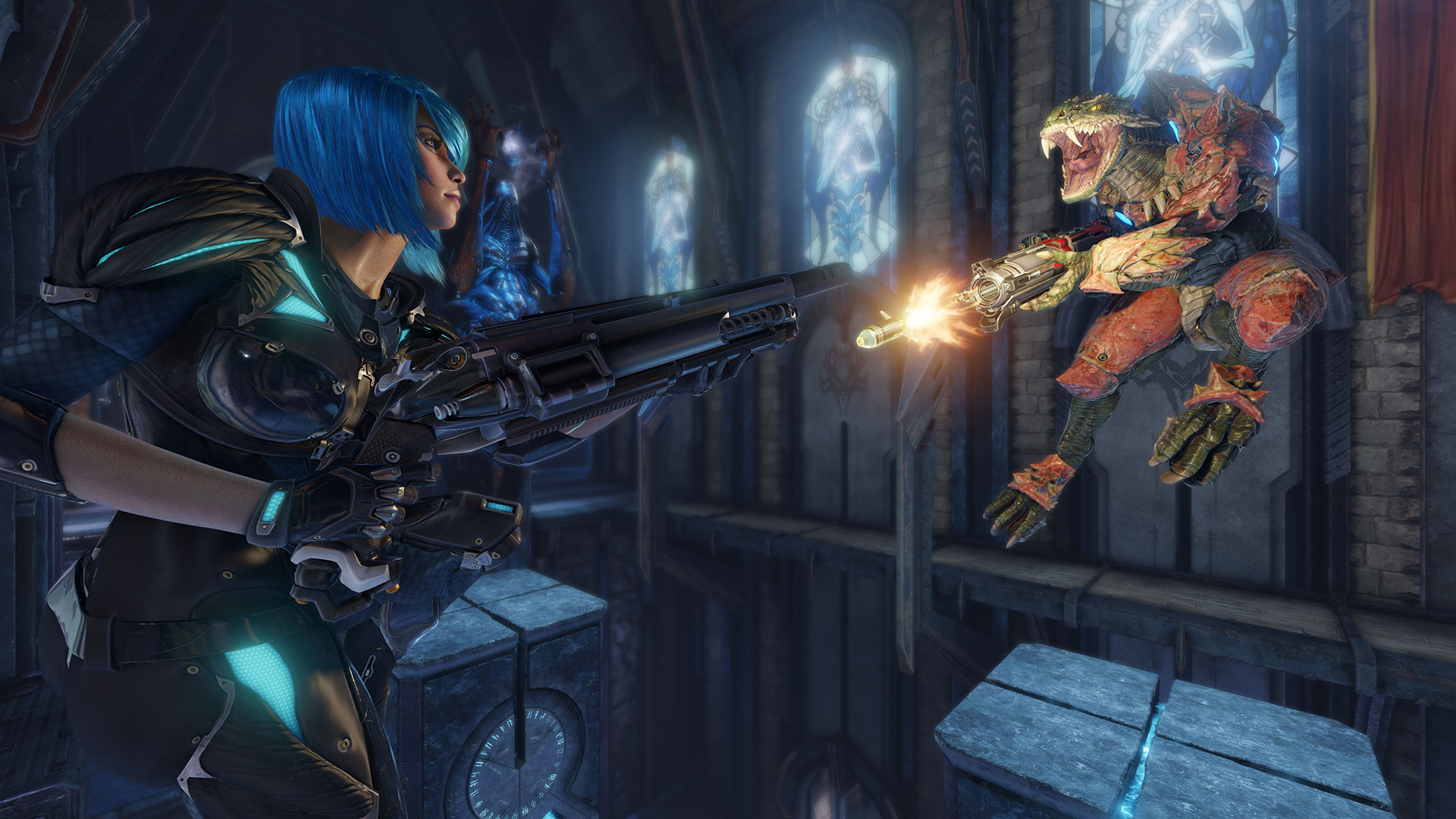The origins of Quake Champions' jumping styles
From Unreal to Challenge ProMode Arena, here's where all of Quake Champion's moves came from.

Look past the 1999 sheen on Quake Champions, and you’ll find an arena shooter that pairs its legendary name with the latest trends in shooters: short cooldowns, stat differences, and ultimate abilities. For better or worse, change has come to Quake, but its movement is undeniably steeped in the decades-long legacy of WASD wizards, drum-n-bass montages, and the almighty power of the strafe key. Here’s a look at the historic origins of the jump styles lifting the boots of some of QC's characters.
Ranger
Jump type: Rocket jump
Seen in: Quake (1996)
How to do it: With the Rocket Launcher equipped, aim directly at the ground beneath or behind yourself, fire a rocket, and jump at the same time.
The rocket jump is the showy axel leap of shooters, its vertical boost an eye-catching epitomization of speed and control rewarded from practiced mastery of mouse and keyboard. Though every Quake Champions character can rocket jump, it’s only fitting that Quake’s own grimacing Ranger takes less damage from the self-harm inflicted by blasting a rocket beneath his boots.
By Ultimate Doom’s release in 1995, id Software clearly understood the basic principle of explosions pushing you around at a higher speed than normal, incorporating hidden secrets reached via the added horizontal boost of speed from a rocket. But it wasn’t until Quake’s full 3D engine that players surprised id with the unexpected jump and rocket combo, a pairing that quickly blossomed into a legend experienced to this day.
------------------------------------------------------------
Doom Slayer
Jump type: Double jump
Seen in: Unreal Tournament 2003 (2002)
How to do it: At the apex of a jump, press jump again.
Hailing from classic platformers, the double jump eventually made its way into arena shooters, but it wasn't id that first made the leap. In a bid to stand apart from id’s titanic presence, Epic introduced its own take on arena shooter mobility with its Unreal Tournament series, including the appearance of the double jump in UT2003. While flashy moves such as the rocket jump crowded the arena acrobat’s spotlight, the double jump was touted as a more precise tool for midair positioning, an on-demand opportunity for the player to correct trajectories and reach perched powerups sans the chaotic nature of damaging yourself to achieve height. It’s made itself at home in shooters ever since, whether rescuing a Scout from an explosive demise in Team Fortress 2 or bridging wallrun chains in Titanfall.
The biggest gaming news, reviews and hardware deals
Keep up to date with the most important stories and the best deals, as picked by the PC Gamer team.
------------------------------------------------------------
Clutch
Jump type: Dodge jump
Seen in: Unreal Tournament (1999)
How to do it: Double tap either the A or D keys.
Tinkering with base WASD movement feels risky in an FPS—if it ain’t broke, and all of that—but Epic took a gamble in 1999 with UT’s dodge jump, a short hop in the direction of a double-tapped movement key. Its jab of speed served to spice up the mundanity of jogging around with a slick feint for evading projectiles and staying unpredictable. Sure, normal strafes get the job done just as effectively, but there’s something magical about dancing away from an instagib rail with a well-timed dodge. For QC’s Clutch, the ability to dodge provides the lumbering bot an agile fallback for heaving his wide frame away from danger or to kickstart a bunnyhop.
------------------------------------------------------------
Nyx
Jump type: Wall jump
Seen in: Unreal Tournament 2004 (2004)
How to do it: While up against or jumping toward a wall, jump again to boost off the wall.
Some jumps came into being to just make you look good. Enter the wall jump, another UT alum that allowed players to carom off vertical surfaces like someone from The Matrix. Epic intended a character fantasy of grizzled and unblooded warriors alike entering a cutthroat futuristic arena to vie for a championship trophy, and only the most fit and deadly combatants would win. The wall jump encapsulated UT’s theme of badassitude and would eventually branch off into its own sphere of influence as players became better at utilizing map geometry to launch higher and farther, even cementing itself as a cornerstone for class design in the current hero-shooter craze.
------------------------------------------------------------
Sorlag, Anarki
Jump type: CPMA
Seen in: Quake 3 Arena (1999)
How to do it: Moving your mouse in relation to your jump direction affords tighter turn control while playing as either Sorlag or Anarki.
The Challenge ProMode Arena (CPMA) mod for Quake 3 was the king of the arena shooter pro scene. It tuned weapon characteristics, movement speed, jump distance values, and much more to vault Q3’s skill ceiling ever higher in an effort to nurture the growing power of professional gaming in the late 1990s—and that included added air control when jumping. The Cyberathlete Professional League adopted CPMA as its standard competitive mod, and it eventually fostered offspring mods such as Defrag that utilized the increased air control and snappier turning angles to stage the artistic side of skillful jumping to a breathtaking degree.
[Gif source: eksha]
------------------------------------------------------------
Visor
Jump type: Strafe jump
Seen in: Quake (1996)
How to do it: Simultaneously tap jump and a strafe key in a repeating pattern alternating between left and right strafes. Add short mouse swipes in the direction of your jumps to increase acceleration.
The strafe jump is the happiest accident in FPS history. In Quake, pressing a movement key while jumping told its code to add some directional speed, but when players discovered that swiping the mouse within a 90 degree arc would amplify acceleration without an upper speed limit, things became beautifully complicated. In other words, it was a bug, but id chose not to implement a fix when strafe jumping’s 'broken' state quickly became canonized as the de facto zenith of mastering speed conservation and getting around quickly. Its straightforward operation of jump, strafe, and swipe masks a deep complexity of muscle memory, math, and pure reflexes that’s driven a push for self-improvement like none other. Load up a custom match by yourself as Visor to experience the best taste of strafe jumping’s possibilities—he boasts the highest speed cap out of any character (a staggering 1600 units of speed over the normal range of 500 to 600), so with enough practice, you can blaze across a map in seconds.
------------------------------------------------------------
Slash
Jump type: Crouch slide
Seen in: Quake 4 (2005)
How to do it: Gather enough speed, jump, and hold crouch right before landing. Jump again near the end of the slide.
A proud badge of honor within the fiercely loyal Quake 4 multiplayer community, the crouch slide was capitalized on as a useful method for flourishing a strafe jump string with an unorthodox escape or a surprising angle for turning corners. Like the strafe jump, a crouch slide relied more on player intuition over simple mechanical key presses, and it saw frequent use in public servers and professional circuits alike. Its contemporary variation has seen much exposure in the jetpack slides of Call of Duty and Titanfall 2. Its original incarnation demanded careful timing between coming out of a slide and launching into a jump, as hitting the spacebar too fast would simply pop you into a standing position and slam you to a halt; a death sentence on the shark-infested arena floor. QC’s bird-flipping Slash luckily augments her crouch slides with a handy boosted jump, and it’s already generating some fantastic plays.
Omri Petitte is a former PC Gamer associate editor and long-time freelance writer covering news and reviews. If you spot his name, it probably means you're reading about some kind of first-person shooter. Why yes, he would like to talk to you about Battlefield. Do you have a few days?


